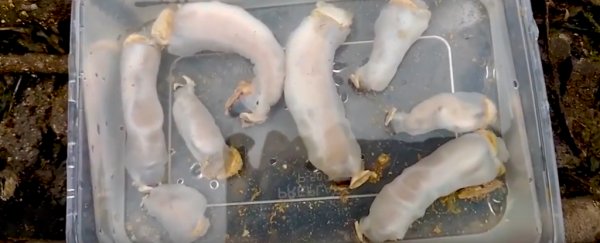Most clams are happy to make their burrow in a nice, soft bed of sand or mud. Not this mollusc. A recently uncovered relative of the shipworm puts the hard into hardcore, chewing holes into rocks and excreting the debris as sand.
Lithoredo abatanica joins a short list of freshwater animals capable of literally weathering the landscape and creating real estate for other species to hide in, while potentially affecting the course of their river ecosystem.
Only thing is, we don't really know why it goes to these lengths.
The tiny, worm-like creature was first spotted back in 2006 during an expedition by the French National Museum of Natural History. While researchers were confident it was a part of the shipworm family of teredinids, they only recently got around to taking a closer look during a biodiversity expedition to the Philippines.
"This one is so unusual we had to create a new genus," says Dan Distel, director of the Ocean Genome Legacy Center at Northeastern University in the US.
"This species is found only in a stretch of this river in the Philippines that runs about three to five kilometres."
Watch the clip below to see Distel's colleagues in the field finding and removing these odd little animals:
A number of specimens were collected from several locations along the Abatan River in eastern Bohol through careful use of a hammer and chisel, before being observed in a tank and then preserved.
Despite their name, shipworms are not actually worms, but rather a kind of bivalve (think mussels and clams). But their elongated bodies don't neatly fit inside their tiny shell, which has instead evolved into a grinding tool to chew up bits of wood for nourishment.
Since ancient times, this ability to chow down on wood has made shipworms the scourge of sea-farers, with infestations of the molluscs making short work of everything from ship hulls to the pylons of piers and jetties.
Species of shipworm can grow to impressive sizes. Kuphus polythalamia is the longest bivalve on the planet, sinking its 1.5 metre (about 5 foot) long body into mangrove mud where bacteria in its gills convert hydrogen sulphide into suitable nutrients.
The new species of teredinid rock-biter sits at the smaller end of the size spectrum, its pale white body barely measuring more than 100 millimetres (about 4 inches) from tip to tail.
Similar to xylotrophic species of shipworm, L. abatanica also sports a shell that has transformed over the eons into a drill-bit for scraping away at hard materials; however, in this case it's not chipping away at wood.
The animal's digging tool is better suited to making short work of limestone, taking the form of dozens of small teeth rather than the hundreds of tiny abrasive bumps that cover the shells of its relatives.
It has other differences, too. Inside most shipworms, microbes turn the soggy splinters sitting in a pouch along their gut into a nutritious soup. The researchers found no hint that the fine bits of sedimentary stone in the digestive tracts of the new species provided much by way of food.
The pulverised rock seems to come out looking much the same as when it went in: fine grit that contributes to the layer of sand at the river bottom. X-ray analysis of the surrounding rock and the animals' waste even revealed they were chemically a match.
For now, scientists are left with little more than speculation, but it's possible the tiny rock-eating molluscs gather their food in a similar way to their giant cousins, with some help from unique bacteria living in their rather large gills. That, or by sucking up scraps from the water through their siphons.
It's clear there are still plenty of mysteries yet to be solved when it comes to the habits of this new group of terepinids, but it could well be worth our effort.
For one thing, studying their ecological habits could tell us a lot about how other organisms in their environment rely on having rocks turned into Swiss cheese for accommodation.
Since rocky burrows can remain preserved for millions of years, we can learn a few tricks from these modern stone masons in order to better understand more ancient specimens.
Closer to home, the bacteria in their gills could also provide us with a new source of pharmaceuticals, potentially whole new classes of antibiotics to help combat the rising menace of drug resistant bacteria.
Researchers are planning on further analysing their genome to get a better idea of where these newly found creatures fit in the shipworm family tree, while potentially solving the mystery of what they eat and why they've evolved to grind up stone in the first place.
This research was published in Proceedings of the Royal Society B.
